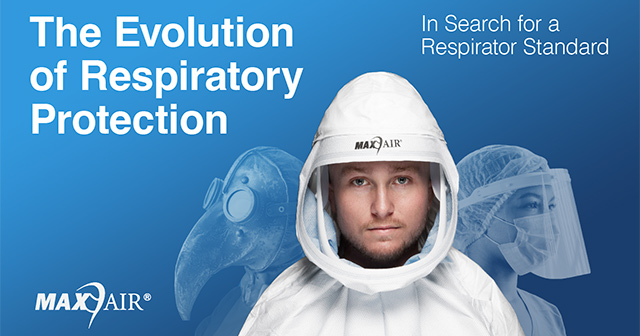Many companies face increasing risks associated with harmful airborne particulates in today's rapidly changing world, including healthcare, construction, pharmaceuticals, manufacturing, and many others.
This has led to the critical development of respiratory protection measures and strict standards to ensure workers' well-being. Here we briefly review the historical development of respiratory protection and current standards adopted by various industries to mitigate respiratory risks.
Historical Perspective: From Ancient Remedies to Modern Science
Respiratory protection has come a long way from the ancient era of animal bladders and the plague mask of the 17th Century. The understanding of respiratory hazards evolved over time, allowing advanced protection methods to be developed.
At the turn of the 20th Century, as industries developed and particulate risks grew more apparent, standardized respiratory protection became imperative. Evidenced by the establishment of the United States Bureau of Mines in 1910, regulatory authorities, industry experts, and scientific organizations worked collaboratively to develop guidelines that would ensure consistent safety across various sectors. The search for those pillar principles upon which to define the standard for respiratory protection was on.
Healthcare Industry: Safeguarding the Frontlines
The healthcare industry plays a vital role in protecting public health and faces numerous infectious respiratory hazards. Respiratory protection standards in healthcare require meticulous precautionary measures to safeguard healthcare professionals and patients alike. Strict guidelines encompass practices such as defining the level of risk for respirator selection, training, fit testing, maintenance, and proper disposal of respiratory protection equipment.
Construction Industry: Creating a Secure Work Environment
Construction sites involve numerous tasks that expose workers to hazardous conditions, including airborne contaminants and irritants. To safeguard workers' respiratory health, this industry adheres to stringent standards that emphasize the correct selection, use, and maintenance of respiratory protective equipment. Regular risk assessments, training, and fit testing are integral parts of respiratory protection protocols.
Pharmaceutical Industry: Protecting the Makers of Life-Saving Products
The pharmaceutical industry develops lifesaving drugs, vaccines, and other medicinal products. As workers in this sector are exposed to potentially harmful particulates, comprehensive respiratory protection standards are paramount. These encompass the use of suitable respirators, regular medical evaluations, and proper cleaning, storage, and equipment maintenance to minimize any risks during production processes.
Other Industries: Tackling Diverse Respiratory Hazards
Numerous other industries, including manufacturing, nuclear, mining, and agriculture, encounter breathing hazards depending on their unique operations. Industries must develop tailored respiratory protection standards based on their specific risks. These standards should include proper risk assessments, ensuring a well-ventilated work environment, and implementing effective control measures to prevent respiratory risks.

Current Standards: Embracing Continual Improvement
Today, industries rely on a range of respiratory protection standards developed by organizations dedicated to worker safety. These organizations include the Occupational Safety and Health Administration and the National Institute of Occupational Safety and Health in the United States, and similar regulatory bodies worldwide. These standards focus on engineering controls, workplace assessments, and training programs that empower employees to recognize and mitigate respiratory hazards effectively.
The development of respiratory protection measures and adherence to robust standards developed over time and across various industries have significantly reduced the risks associated with harmful particulates and breathing hazards. Research, innovation, and collaboration help industries improve respiratory protection protocols for workers' well-being. Continual evaluation of standards, however, reveals current standards are not always met or working as intended.
The latest advancements in technology and increased understanding of respiratory risks will undoubtedly result in further enhancements to safeguard the health of professionals across different sectors. We believe the way forward is to define a new standard in respiratory protection that is more applicable across multiple industries - one that recognizes the shortcomings of current standards and addresses them for a healthier future.
We’ll discuss the evolution towards a specific respirator standard of care in more detail in the next edition of our blog series. Stay tuned!



